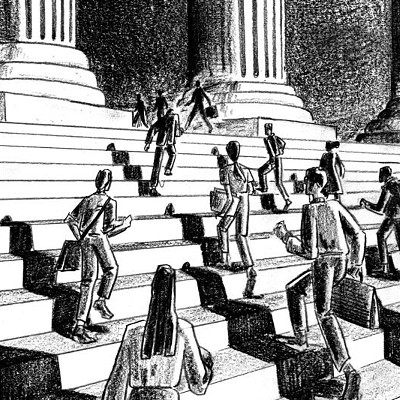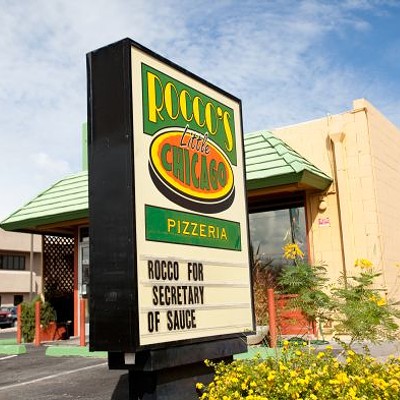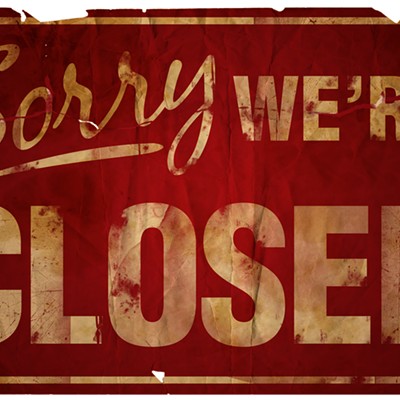Garcia, 38, is an inmate at the Arizona state prison on South Houghton Road. He is one of 17 to 21 inmates working in the MVD call center there. If you call and he or one of his colleagues doesn't know the answer to your question, or if your query involves necessary personal information, Garcia will bump your phone call up to a second tier, where MVD employees outside the prison will take over and answer your questions.
The prison call center is one of three Arizona Correctional Industries in the Tucson state prison complex. Another is a sign shop where 28 to 34 inmates make signs and decals for use on public vehicles and buildings. The third is a facility in which doors and windows are manufactured for Solar Industries of Tucson.
The call center was born out of need, according to Robert Greenberg, an MVD employee who supervises the operation. "The big problem with communications in past years with MVD has always providing timely service answering the phones," said Greenberg. "Because of so many people calling up, there was always a long wait time--people on hold up to 45 minutes. So, in 1996, this program was developed. When people call MVD, the phones are answered by [an inmate at a] level-1 call center who gives out basic information."
People ask how to get a driver's license, where to go for an emission test and so forth. "If it becomes any more involved than that," said Greenberg, "requiring access to someone's personal information, the inmate transfers the call to a level-2 call center, located at MVD headquarters in Tucson or Phoenix, where regular state employees use computer terminals to access to driver information." Inmates operate two other level-1 call centers in prison complexes in the Phoenix area.
The inmate centers have shouldered a heavy burden of calls. "In February," said Greenberg, "we had 25,189 calls. We handled 55 percent of them at this level." The prison facility has call stations for 21 inmates. The center has a fairly regular turnover among inmates who have completed their sentences. Garcia, for example, is scheduled for release in a few weeks.
Call-center jobs are sought after. "They're considered the 'cake' jobs," said Robin Johnson, a former inmate. "We look for inmates who want to improve themselves," said Greenberg, "men who have the least amount of disciplinary problems. We'd like them to have at least six months, maybe a year left to serve on their sentence. But no more than four years. We're looking for stability."
Not everyone can qualify. "These guys are our best," said Greenberg. "They are processed to make sure they have good mental health. They also have higher educational levels--a high school diploma or a GED is required. We also want them to continue their education in a college program and keep up in a substance-abuse program, if that is something involved in their coming to prison."
Inmates earn 50 to 80 cents an hour, with a 5-cent raise every six months. Other prison industries pay 40 to 80 cents an hour. Solar Industries pays the prevailing wage, $6 an hour, to the prison for the inmates it employs. A substantial amount of that goes not to the inmates, but to Arizona Correctional Industries (ACI) for administrative and other costs.
There are two categories of correctional industries--those owned and operated by and for the state, ranging from furniture manufacturing to printing, needle trades to making recreation equipment and growing crops. The only objection to such enterprise has come from the Printing Industries Association. It wants ACI not to bid on jobs except for those of "in-house" state government agencies.
Aside from its owned and operated industries, ACI contracts to perform labor for private sector companies. In the Tucson prison complex, Solar Industries is the only outside contractor. Mike Parvis, Solar's vice president, said the ACI deal solved a labor shortage. "That's how we got started. We couldn't find anybody to hire. And [ACI] was an alternative to that." Besides the Tucson unit, Solar Industries has manufacturing facilities in prisons in Florence and Yuma. It also employs 170 in its own facilities outside of the prison. It sells screens and windows throughout the world.
One of ACI's achievements is bringing in revenue for the prison system (2001 operating income was $761,063, down from more than $1 million a year earlier). Theoretically, it is also supposed to help rehabilitate (or "habilitate," as Warden Charles Flanagan said) participating inmates, giving them work experience or a trade they can use after release.
However, there is no certainty that pasting decals on police cars or answering MVD phone calls changes longtime habits among inmates. Studies indicate that inmates in work programs probably have the same rate of recidivism (repeat offenses) as their non-participating prison mates. The Arizona prison system's division of human resources and development is currently studying the rate of recidivism among inmates in the Correctional Industries programs, but will not have any results until summer.
Meanwhile, a study of recidivism conducted by a Minnesota legislative researcher indicated that "presumed beneficial effects of prison labor on inmate behavior" did not justify optimism. The Minnesota researchers cited a "major federal study" that "provided evidence of [only] a modest yet positive link between prison industry participation and recidivism."
Recidivism among released felons is a murky subject. Dr. Daryl R. Fischer, research manager for the Arizona prisons planning bureau, conducted study of 38,000 inmates over more than nine years. He found that "more than 50 percent return within that period." Over a longer period, Fischer said he believes as many as 60 to 65 percent of released felons will return to prison.
Despite that gloomy outlook, the Arizona crime rate has been actually declining since 1991. "A number of factors are involved--more incarceration is taking criminals off the street. Also, the aging of the criminal population, with people moving out of the most crime-prone age categories," Fischer said. But with an increasing population, it means more criminals are being incarcerated. While crime rates have dropped to the level of the 1960s, there are many more convicts in prison.
A mixed blessing, at best.












